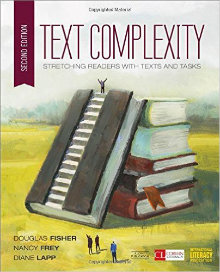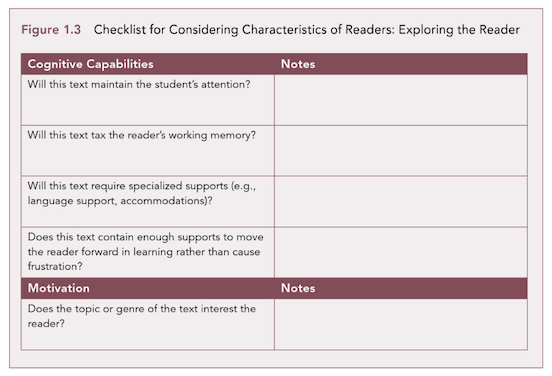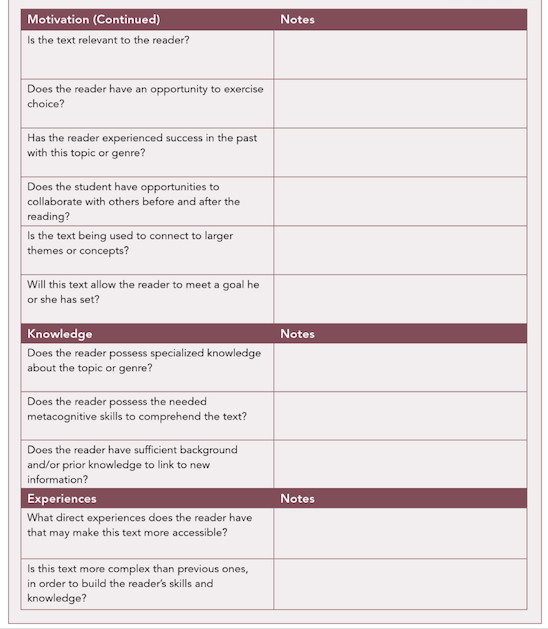Expert Advice for Working with Complex Texts
Text Complexity: Stretching Readers with Texts and Tasks, Second Edition
By Douglas Fisher, Nancy Frey, and Diane Lapp
(Corwin Literacy, 2016 – Learn more)

Readers won’t be disappointed with the Second Edition of Text Complexity: Stretching Readers with Texts and Tasks. Douglas Fisher, Nancy Frey, and Diane Lapp want teachers to use the ideas and suggestions from this book “to support every student in becoming more skilled at reading complex texts.” (p. xiv)

Eye catching passages
While reading the first four chapters, I was reminded of our responsibilities for designing and planning instruction. As a result, my copy is filled with stars, asterisks, and sticky notes. Anytime there was mention of a text that I like or use, I circled the title. Here are a few of the sentences/passages that spoke to me.
It’s a question not so much of whether they [students] possess the necessary prior knowledge and background experiences but of whether they are able to marshal these resources when needed.” (p. 10)
That’s why modeling is so important – we have to teach them how to find what they know.
I loved the checklists Exploring the Reader (pp. 11-12) and Exploring the Text (pp.14-15). Here’s the first:
As it turns out, I discovered several useful charts and checklists in the book; unfortunately, I did not see that these were available to download.
Text complexity matters because student learning matters.” (p.20)
That statement comes following the section on “The Case for Struggle,” and it made me reflect on striking that balance between too easy/too difficult.
In the chapter on Quantitative Measures of Text Complexity, the following sentence got an asterisk:
Readability, after all, should never be confused with reading ability.” (p. 38)
I marked this sentence to remind myself that it’s all about perspective.
A teacher who has worked with affluent, high-performing students may rate a text differently than a teacher who has supported struggling readers.” (p.66)
As I moved into the new material, I found even more ideas worth marking and sharing. In Chapters 5–9, teachers will find a wide range of tasks designed to help students read complex texts with competence and confidence.
Guidance for modeling
Teachers who include modeling in their instructional practices increase their students’ chances of accessing complex texts. Fisher, Frey, and Lapp’s research and work supports two key components of modeling: 1) the use of “I” statements and 2) verbalization that includes the because, why, or how of thinking. With the Design a Think-Aloud found on page 102 and the classroom scenarios, teachers can gain new insights into modeling.
Close reading resources
In the section on close reading lessons, the authors share their knowledge on selecting short worthy passages, rereading, reading with a pencil, and discussing the text. Again, readers will find the teacher-to-student and the student-to-student dialogue beneficial. These examples show instruction that ensures “that students can think deeply, look for evidence, and justify their ideas and proclamations.” (p. 141)
I thought Chapter 8, Exploring Peer-Led Tasks, was my favorite chapter until I got to Chapter 9, Exploring Individual Tasks. Then it was a toss-up! (You can view the book’s complete contents in the Amazon viewer if you have an Amazon account.)
Text Complexity: Stretching Readers with Texts and Tasks, Second Edition by Douglas Fisher, Nancy Frey and Diane Lapp is an excellent choice for your professional library. It is easy to read and is filled with useful examples and strategies. This second edition, co-published with the International Literacy Association, will “stretch” both teachers and students!
Anne Anderson is currently an educational consultant known for her practical ideas and engaging workshops. Anne’s goal is to help teachers help students. Her positive approach and sense of humor bring encouragement to her audiences. Anne seeks to provide educators with practical solutions to teaching and learning problems. Visit her website www.AnneAndersonEdu.com and subscribe to her bi-monthly newsletter Spotlight on Success.



































